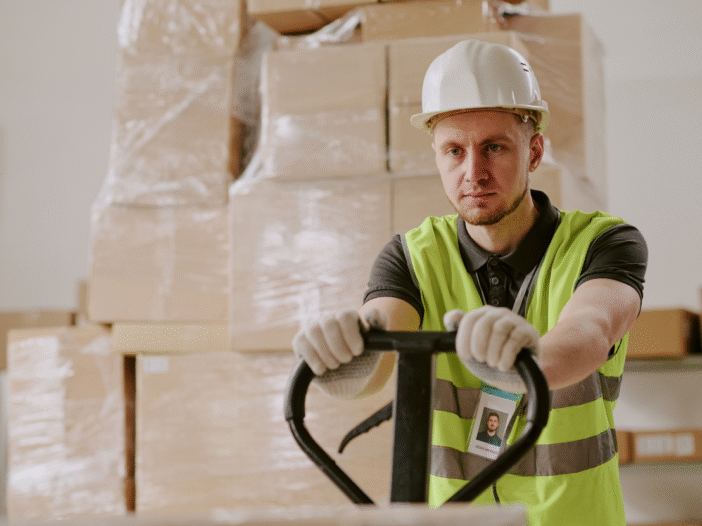
Under the Manual Handling Operations Regulations 1992, employers have a responsibility to reduce the risk of manual handling injuries as ‘far as reasonably practicable’ by avoiding the need for employees to undertake manual handling tasks where there is a risk of injury.
One in three accidents at work is caused by manual handling, so it is important that every precaution is taken to keep people safe.
When manual handling cannot be avoided, team lifting is one way to reduce manual handling risk because the strain is reduced if the load is shared.
Here are our 10 top tips to help ensure team manual handling is carried out as safely as possible.
1. Assess weight
Before attempting to lift a load, visually inspect its size, shape, and density. This can give you an initial indication of its weight.
Try to lift one corner of the object to gauge its weight. This can help you decide how much assistance you need.
Keep in mind that the weight of a load may change depending on its contents, and it may feel heavier when it’s in motion (for example, swinging or shifting).
Consider using a handling aid such as straps, slings, or handles to provide better control and leverage, as these can help distribute the weight evenly between team members. If the load is too heavy for manual lifting think about using mechanical aids such as carts, conveyors, cranes, forklifts, hoists, or pallet trucks.
2. Assess height
Determine the height the object needs to be lifted to reach the destination.
Different lifting techniques may be required depending on the height of the lift. For example, when lifting objects from floor to shoulder height you may need to rest the load on a table part-way so the team can change grip.
Position team members strategically around the object to optimise the lifting process for the required height. Assign specific roles based on each person’s strengths to ensure efficient lifting.
As the object is lifted, focus on maintaining stability and balance. Avoid sudden movements or jerks that could cause the object to tip or become unstable.
If the object needs to be lifted to a considerable height, consider using mechanical aids (see ‘Assess the weight’ above).
3. Consider environment
Before lifting, conduct a thorough assessment of the lifting environment to identify potential hazards.
Ensure pathways are clear of obstacles and debris to provide a safe, unobstructed route for lifting and transporting. Inspect the condition of the flooring to identify any areas that may be uneven, slippery, or otherwise hazardous. Address any issues like spills, cracks, or loose flooring materials that could increase the risk of slips, trips or falls during lifting.
Ensure entrances, exits and pathways are wide enough to accommodate the size of the load and allow for easy movement. Think about whether there are people not involved in the lift who might get in the way.
Make sure the lifting area is adequately lit. Poor lighting can obscure obstacles or hazards, increasing the risk of injuries. Use additional lighting sources or portable lights to improve visibility in dimly lit areas.
Consider how temperature, humidity and ventilation can impact the safety and comfort of the team during lifting. If lifting tasks are performed outdoors consider traffic movements and monitor weather conditions that could affect the stability of the load and increase the risk of slips and falls. Decide whether manual handling can be avoided and, if not, what precautions can be taken to minimise risk.
4. Communicate effectively
Effective communication is the key to manual handling safety when team lifting. Before lifting make sure the team understands their responsibilities and are aware of potential hazards.
Clearly define each person’s role, including who will lead the lift, who will provide support and who will supervise the process. This avoids confusion and ensures everyone knows what is expected of them.
Communicate verbally with team members to coordinate movements during the lift. Use clear, concise instructions to convey information, such as “Ready to lift”, or “Lowering now”, to ensure everyone’s actions are synchronized. You could have a counting system to synchronise lifting and lowering movements.
You might establish hand signals or gestures to convey specific messages during the lifting process. This is useful in noisy environments or where verbal communication is limited.
Encourage continuous communication so team members ask questions if they are unsure about any aspect of the lift. It is important that they alert each other to potential hazards or obstacles as they go, and coordinate adjustments as needed.
Talk to the team throughout the lift to keep everyone informed of progress and address any issues. Be prepared to adapt the initial plan as needed to improve efficiency and manual handling safety.
5. Minimise twisting
Avoid twisting the body while lifting or carrying objects because this can strain muscles and cause injuries. Plan the lifting route in advance to minimise the need for twisting movements.
Start by assessing the pathway to the destination and clearing hazards. Plan the route to avoid obstacles, tight spaces, and uneven surfaces.
Position the object in a way that minimises the need for twisting during lifting. Ensure the object is squarely in front of team members, aligning it with the direction of movement to reduce the risk of awkward postures or twisting motions.
Emphasise the importance of using proper lifting techniques. Encourage team members to bend their knees (see below), keep a neutral spine (which means a straight back), and lift with their legs rather than relying on the back muscles. This helps maintain proper alignment and reduces strain on the spine.
6. Bend knees
Bending the knees is a fundamental aspect of proper body mechanics during lifting. It allows the legs to bear the weight of the load, rather than placing excessive strain on the lower back muscles. By lowering the centre of gravity, it also reduces the risk of losing balance or tipping over during the lift.
The lower back is particularly susceptible to strain and injury when lifting heavy objects. Bending the knees engages the large muscle groups in the legs, including the quadriceps, hamstrings, and glutes. These muscles are more able to manage the demands of lifting, relieving pressure on the back.
Bending the knees promotes a neutral spine alignment, where the natural curves of the spine are preserved. This reduces the risk of spinal compression and disc herniation that can occur with improper lifting techniques. It allows for a more ergonomic approach to lifting, reducing the likelihood of jerky movements or sudden shifts in posture.
7. Grip securely
Team members should place their hands securely on the load, using a grip that feels comfortable and stable. Encourage them to spread their fingers evenly and grip the object firmly without squeezing too tightly.
Emphasise the importance of proper hand positioning to maintain a secure grip throughout the lifting process. Encourage the team to adjust their hand placement as needed to maintain balance and control, but to do so smoothly. Sudden shifts in grip could cause the object to slip.
When lifting heavy or awkward loads, consider using lifting aids such as handles, straps or grips to distribute weight more evenly and reduce the strain on hands.
Provide gloves if needed, especially when handling rough or abrasive surfaces or objects with sharp edges. Gloves improve grip and protect hands from blisters, cuts, and abrasions.
Choose gloves that are appropriate for the task considering factors such as grip strength, flexibility, and protection level. Anti-slip or textured gloves can provide traction, especially when lifting heavy or slippery objects.
Regularly inspect gloves to make sure they are free from tears, holes or damage that could compromise their effectiveness.
8. Maintain proper posture
It is important to maintain a straight back and engage core muscles throughout the lift. Maintaining proper posture distributes the weight of an object evenly throughout the body, reducing the strain on any one area. This minimises the risk of muscle fatigue and manual handling injuries.
After completing the lift, encourage team members to do gentle stretching exercises to alleviate muscle tension and reduce the risk of stiffness or soreness. Focus on stretching the back and shoulders.
9. Minimise manual handling time
If lifting tasks are repetitive or prolonged, rotate lifting positions among team members to prevent muscle fatigue and reduce the risk of overuse injuries.
Consider implementing job rotation strategies where team members alternate between lifting tasks and other activities to minimise prolonged exposure to repetitive lifting movements.
It is important to plan in adequate rest breaks and to think about how to minimise the time each individual spends lifting heavy objects.
10. Manual handling safety training
Manual handling training encourages a culture of safety where employees proactively take steps to protect themselves and their colleagues from injuries.
Our Manual Handling Course helps employees across all sectors to recognise and mitigate the risks of manual handling when they are lifting by themselves or as part of a team. By the end of the manual handling safety course, they will be able to conduct a manual handling risk assessment, understand basic manual handling techniques, know when to avoid manual handling and what equipment can be used to reduce risks.
We also offer Manual Handling in the Office which raises awareness of manual handling hazards in the office and what steps can be taken to prevent musculoskeletal disorders.

Adam Clarke
Managing Director (Consulting)
